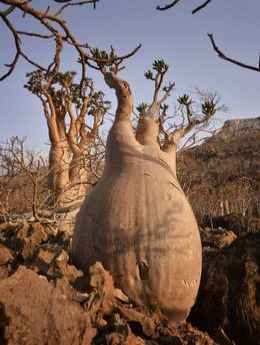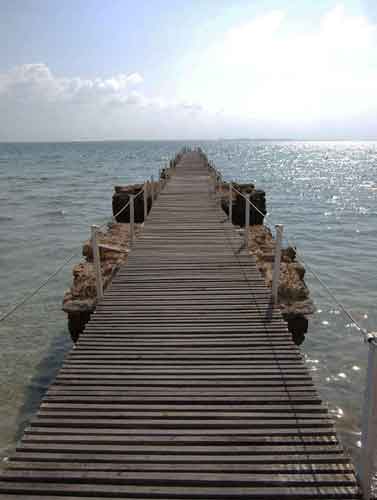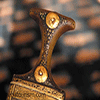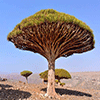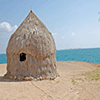History
Yemen is one of the oldest centers of civilization in the world. Between
the ninth century BC and the sixth century AD, it was part of the Sabaean,
Awsanian, Minaean, Qatabanian, Hadhramawtian, Himyarite, and some other
kingdoms, which controlled the lucrative spice trade. It was known to the
Ancient Romans as Arabia Felix ("Lucky Arabia") because of the riches its
trade generated. Augustus Caesar attempted to annex it, but the expedition
failed. The Ethiopian Kingdom of Aksum annexed it by around 520, and it was
subsequently taken by the Sassanids Persians around 570.
In the 3rd century and again in the late sixth and early seventh centuries
AD, many Sabaean and Himyarite people migrated out of the land of Yemen
following the destructions of the Ma'rib Dam (sadd Ma'rib) and migrated to
North Africa and northern part of the Arabian Peninsula. In the 7th century,
Islamic caliphs began to exert control over the area. After this caliphate
broke up, the former North Yemen came under control of Imams of various
dynasties usually of the Zaidi sect, who established a theocratic political
structure that survived until modern times.
(Imam is a religious term. The Shi'ites apply it to the prophet Muhammad's son-in-law Ali, his sons Hassan
and Hussein, and subsequent lineal descendants, whom they consider to have
been divinely ordained unclassified successors of the prophet.)
Egyptian Sunni Caliphs occupied much of North Yemen throughout the eleventh
century. By the sixteenth century and again in the nineteenth century, north
Yemen was part of the Ottoman Empire, and in some periods its Imams exerted
control over south Yemen.
North Yemen became independent of the Ottoman Empire in 1918 and became
a republic in 1962. In 1839, the British occupied the port of Aden and
established it as a colony in September of that year. They also set up a
zone of loose alliances (known as protectorates) around Aden to act as a
protective buffer. In 1967, the British withdrew and gave back Aden to
Yemen due to extreme pressure of battles with the North and Egyptian allies.
After the British withdrawal, this area became known as South Yemen. The two
countries were formally united as the Republic of Yemen on May 22 1990.
Politics
Yemen is a republic with a bicameral legislature. Under the constitution,
an elected president, an elected 301-seat House of Representatives, and an
appointed 111-member Shura Council share power. The president is head of
state, and the prime minister is head of government. The constitution
provides that the president be elected by popular vote from at least
two candidates endorsed by Parliament; the prime minister is appointed
by the president. The presidential term of office is seven years, and the
parliamentary term of elected office is six years. Suffrage is universal
over 18 years of age.
President Ali Abdullah Saleh became the first elected President in reunified
Yemen in 1999 [though he had been President of unified Yemen since 1990 and
President of North Yemen since 1978] and most recently was re-elected in
September of 2006 after an initial reluctance to run once more. His victory
was marked by an election that international observers judged to be
"generally free and fair." Popular demonstrations and editorials of support
in major papers helped change his mind to run again. In April 2003
parliamentary elections were held, and the General People's Congress (GPC)
maintained an absolute majority.
The constitution calls for an independent judiciary. The former northern
and southern legal codes have been unified. The legal system includes
separate commercial courts and a Supreme Court based in Sana?. Since
the country is an Islamic state, the Islamic holy book, the Qur'an, is the
basis for all laws, and no law may contradict the Qur'an. Indeed many court
cases are debated by the religious basis of the laws i.e. by interpretations
of the Qur'an. For this reason, many Judges are religious scholars as well
as legal authorities. Unlike Saudi Arabia and other Islamic states, the
consumption of alcohol by foreigners is tolerated, and the mild stimulant
Qat is chewed by Yemenis of all strata of society, despite being banned or
frowned upon by other Islamic countries and groups.
The political elites of Yemen are the Hashid tribe and the Bakeel tribe.
President Ali Abdullah Saleh and the Speaker of the Parliment are from the
Hashid Tribe.
Economy
In terms of GDP per capita, Yemen is one of the poorest countries in the
Arab world. Remittances from Yemenis working abroad and foreign aid paid for
perennial trade deficits. Substantial Yemeni communities exist in many
countries of the world, including Yemen's immediate neighbors on the Arabian
Peninsula, Indonesia, India, East Africa, and also the United Kingdom, and
the United States, especially in the area around Detroit, Michigan.
Beginning in the mid-1950s, the Soviet Union and China provided large-scale
assistance. For example the Chinese are currently involved with the
expansion of the International Airport in Sanaa.
In the south, pre-independence economic activity was overwhelmingly
concentrated in the port city of Aden. The seaborne transit trade, which
the port relied upon, collapsed with the closure of the Suez Canal and
Britain's withdrawal from Aden in 1967.
Since unification, the government has worked to integrate two relatively
disparate economic systems. However, severe shocks, including the return in
1990 of approximately 850,000 Yemenis from the Gulf states, a subsequent
major reduction of aid flows, and internal political disputes culminating
in the 1994 civil war hampered economic growth. Yemen, the fastest growing
democracy in the Middle East, is attempting to climb into the middle human
development region through ongoing political and economic reform.
Since the conclusion of the war, the government entered into agreement with
the International Monetary Fund (IMF) to implement a structural adjustment
program. Phase one of the IMF program included major financial and monetary
reforms, including floating the currency, reducing the budget deficit, and
cutting subsidies. Phase two will address structural issues such as civil
service reform.
In early 1995, the government of Yemen launched an economic, financial and
administrative reform program (EFARP) with the support of the World Bank
and the IMF, as well international donors. The First Five-Year Plan (FFYP)
for the years 1996 to 2000 was introduced in 1996. The World Bank has
focused on public sector management,including civil service reform, budget
reform and privatization. In addition, attracting diversified private
investment, water management and poverty-oriented social sector improvements
has been made a priority for the implementation of the programs in Yemen.
These programs had a positive impact on Yemen?s economy and led to the
reduction of the budget deficit to less than 3% of GDP during the period
1995-99 and the correction of macro-financial imbalances.[1]
In 1997, IMF and the government began medium-term economic reform programs
under the Enhanced Structural Adjustment Facility (ESAF) and Extended Fund
Facility (EFF). This reform program was aimed at reducing dependence on the
oil sector and establishing a market environment for real non-oil GDP growth
and investment in the non-oil sector. Increasing the growth rate in the
non-oil sector was one of the most important problems to be tackled by the
government. These programs included reducing unemployment, strengthening the
social safety net and increasing financial stability. To achieve these
reforms, the government and IMF implemented containment of government wages,
improvements in revenue collection with the introduction of reforms in tax
administration, and a sharp reduction in subsidies bills by increasing
prices on subsidized goods. As a result, the fiscal cash deficit was reduced
from 16 percent of GDP to 0.9 percent from 1994 to 1997. This was supported
by aid from oil export countries despite the wide-ranging fluctuations in
world oil prices. The real growth rate in the non-oil sector rose by 5.6
percent during 1995-97. [2]
The World Bank is active in Yemen, with twenty-two active projects in 2004,
including projects to improve governance in the public sector, water, and
education. In 1996 and 1997, Yemen has lowered its debt burden through Paris
Club agreements and restructuring U.S. foreign debt. In 2003, government
reserves reached $5 billion.
The main oil produced and used in Yemen is Marib oil. Marib oil contains
associated natural gas. Proven reserves of 10 to 13 trillion cubic feet
(283 to 368 km?) could sustain a liquid natural gas (LNG) export project.
Geography
Yemen is in the Middle East, in the south of the Arabian Peninsula,
bordering the Arabian Sea, Gulf of Aden, and Red Sea, west of Oman and
south of Saudi Arabia.
A number of Red Sea islands, including the Hanish Islands, Kamaran and
Perim, as well as Socotra in the Arabian Sea belong to Yemen.
At 203,837 mi? (527,970 km?), Yemen is the world's 49th-largest country
(after France). It is comparable in size to Thailand, and somewhat larger
than the U.S. state of California. Yemen is found at 15? N 48? E.
Until recently its northern border was undefined because the Arabian
Desert prevented any human habitation there.
The country can be divided geographically into four main regions: the
coastal plains in the west, the western highlands, the eastern highlands,
and the Rub al Khali in the east.
The Tihamah ("hot lands") form a very arid and flat coastal plain. Despite
the aridity, the presence of many lagoons makes this region very marshy and
a suitable breeding ground for malarial mosquitoes. There are also
extensive crescent-shaped sand dunes. The evaporation in the Tihama is so
great that streams from the highlands never reach the sea, but they do
contribute to extensive groundwater reserves; today these are heavily
exploited for agricultural use.
The Tihamah ends abruptly at the escarpment of the western highlands.
This area, now heavily terraced to meet the demand for food, receives
the highest rainfall in Arabia, rapidly increasing from 100 mm (4 inches)
per year to about 760 mm (30 inches) in Ta'izz and over 1,000 mm
(40 inches) in Ibb. Agriculture here is very diverse, with such crops
as sorghum dominating, but cotton and many fruit trees are also grown,
with mangoes being the most valuable.
Temperatures are hot in the day but fall dramatically at night. There are
perennial streams in the highlands but these never reach the sea because of
high evaporation in the Tihama.
The central highlands are an extensive high plateau over 2,000 metres
(6,560 feet) in elevation. This area is drier than the western highlands
because of rain-shadow influences, but still receives sufficient rain in
wet years for extensive cropping. Diurnal temperature ranges are among the
highest in the world: ranges from 30 ?C (86 ?F) in the day to 0 ?C (32 ?F)
at night are normal.[citation needed] Water storage allows for irrigation
and the growing of wheat and barley. Sana'a is located in this region. The
highest point in Yemen is Jabal an Nabi Shu'aya, at 3,760 meters (12,336 ft).
The Rub al Khali in the East is much lower, generally below 1,000 metres,
and receives almost no rain. It is populated only by Bedouin herders of
camels.
Languages
While the national language is Arabic (spoken in several regional dialects),
Yemen is one of the main homelands of the South Semitic family of languages,
which includes the non-Arabic language of the ancient Sabaean Kingdom. Its
modern Yemeni descendants are closely related to the modern Semitic
languages of Eritrea and Ethiopia. However, only a small remnant of those
languages exists in modern Yemen, notably on the island of Socotra and in
the back hills of the Hadhramaut coastal region. Modern South Arabian
languages spoken in Yemen include Mehri, with 70,643 speakers, Soqotri,
with an estimated 43,000 speakers in the Socotra archipelago (2004 census)
and 67,000 worldwide, and Bathari (with an estimated total of only 200
speakers).
Foreign language in public schools is taught from grade seven on, though
the quality of public school instruction is low. Private schools using a
British or American system teach English and produce proficient speakers,
but Arabic is the dominant language of communication. The number of English
speakers in Yemen is small compared to other Arab countries such as Egypt,
Lebanon, the UAE and Saudi Arabia. Private schools have also started to
teach French alongside Arabic and English.







